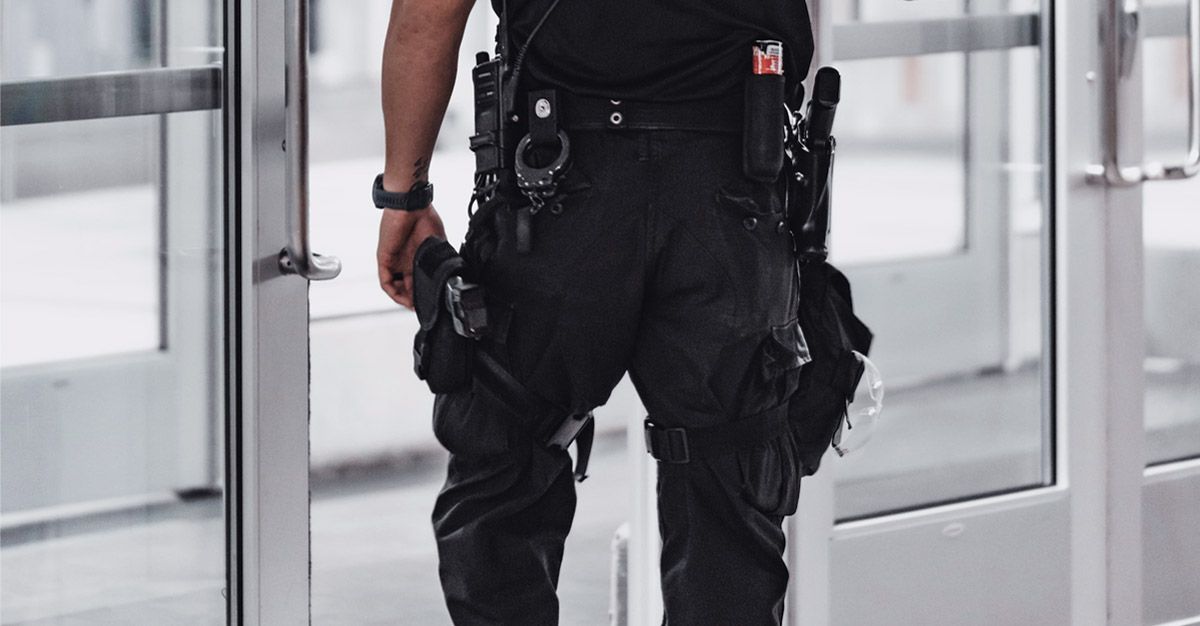Säkerhetsdörrar RC5 inkluderas i kategorin av de mest pålitliga och robusta säkerhetsdörrarna på marknaden idag. Dessa dörrar är konstruerade för att motstå tunga attacker och skydda mot välplanerade inbrott och intrång. En RC5-säkerhetsdörr är testad enligt den europeiska standarden EN 1627 och har fått klassificeringen RC5.
Vad detta innebär är att dörren har klarat av ett flertal test, men primärt ett 40 minuters inbrottsförsök utfört av erfaren inbrottstjuv med en effektiv angreppstid om 15 minuter. Inbrottstjuven har haft tillgång till en stor arsenal av maskindrivna verktyg som kofot, hammare, vinkelslip (125 mm diameter), tigersåg, borrmaskin med hårdmetallborr. Trots tillgång till kraftfulla och effektiva verktyg har inbrottstjuven stora svårigheter med att bryta upp en RC5 säkerhetsdörr. Notera att 15 minuters effektiv angreppstid är aktivt borrande, bankande, sågande vilket är näst intill fysiskt omöjligt att utföra utan pauser, därmed blir angreppstiden 40 minuter. Troligen kan tiden kortas ned aningen om flertalet inbrottstjuvar turas om att utföra det effektiva angreppet.
En av de största fördelarna med RC5-säkerhetsdörrar är dess solida material. Dörrarna vanligtvis tillverkade av höghållfast stål och har ett dörrblad med en tjocklek på minst 70 mm. Detta kan jämföras med en RC2 dörr som vanligen har ett dörrblad om runt 50 mm. Bara gällande tjocklek är en RC5 dörr 2 cm tjockare vilket ger en väldigt mycket mer massiv och svårgenomtränglig dörr. Dörren är också förstärkt med extra metallplattor och stöd för att motstå attacker.
RC5-säkerhetsdörrar är också utrustade med flera låssystem, inklusive cylinderlås och flerpunktslås, vilket gör dem ännu säkrare. Dessa lås är tillverkade av högkvalitativt material och är svåra att bryta upp eller forcera.
En annan fördel med RC5-säkerhetsdörrar är deras anpassningsbarhet. De är byggda med färdiga håligheter för addering av elektronik och tillval. Allt planeras från ritningsbordet och mängden anpassningar och tillval är näst intill obegränsade. Ni kan välja mellan olika färger, storlekar och stilar för att passa era specifika behov och preferenser. Dörrarna kan också anpassas för extra funktioner som till exempel brandsäkerhet, skottsäkerhet, explosionsskydd och ljudisolering.
En RC5-säkerhetsdörrar är en investering i er säkerhet och trygghet. Att installera en högsäkerhetsdörr kan minska era försäkringskostnader och öka värdet på er byggnad eller ert företag. Dessutom kan en RC5-säkerhetsdörr ha en positiv psykologisk inverkan genom att minska stress och oro.
Var testas RC5 säkerhetsdörrar?
Säkerhetsdörrar RC5 testas enligt standarder som fastställts av den europeiska standardiseringsorganisationen CEN (Comité Européen de Normalisation). Testen utförs av oberoende testinstitut som har ackreditering för att utföra tester enligt standarderna. Tester som ligger till grund för standarden utförs vanligtvis i Tyskland, Belgien eller Nederländerna.
Den vanligaste standard som används för att testa säkerhetsdörrar RC5 är EN 1627 som fördelas i olika RC (Resistance Class). EN 1627-1630 definierar sex olika klasser av inbrottsskydd för dörrar, från RC1 till RC6. RC5 är den näst högsta klassen och kräver att dörren kan motstå ett 40 minuters inbrottsförsök med tunga verktyg.
Det är viktigt att notera att testerna inte bara omfattar själva dörren, utan också dess montering och låssystem. Därför är det viktigt att säkerställa att dörren installeras korrekt och med rätt låssystem för att den ska kunna uppfylla kraven i RC5-klassen.
Köper ni säkerhetsdörrar som är testade och godkända enligt dessa standarder kan ni därmed vara säkra att de uppfyller högsta krav på inbrottsskydd och att dörren kommer att erbjuda en hög skyddsnivå mot intrång.
Var förekommer Säkerhetsdörrar RC5 och vad är dess användningsområden?
RC5-säkerhetsdörrar används i olika miljöer där säkerhet är av högsta vikt. Dörrarna är särskilt lämpliga för att skydda mot inbrott och intrång, men de kan också användas för att hindra obehörig tillgång till känsliga eller skyddade områden. Exempel på platser där RC5-säkerhetsdörrar ofta används inkluderar banker, myndigheter, häkten, sjukhus, flygplatser, kontor och privata bostäder.
I banker och butiker skyddar RC5-dörrar mot inbrott och stölder. De ger en högre nivå av säkerhet för att förhindra att obehöriga personer bryter sig in och stjäl pengar, värdesaker eller varor. RC5-säkerhetsdörrar kan också skydda känsliga områden i banker, såsom valv och säkerhetsrum.
Inom sjukvården kan RC5-dörrar användas för att skydda patienter och personal mot hot från våldsamma eller aggressiva patienter. De kan också användas för att skydda medicinska förnödenheter och utrustning.
Inom kontorsmiljöer skyddar RC5-dörrar mot intrång, stöld och obehörig tillgång till känsliga dokument och information. RC5-dörrar kan också användas för att skydda datacenter och andra känsliga tekniska områden.
I privata bostäder ger RC5-säkerhetsdörrar en hög nivå av skydd mot inbrott. De kan också användas för att ge extra högt skydd mot hot som brand och gasläckor.
Generellt sett är RC5-säkerhetsdörrar en viktig del av ett effektivt säkerhetssystem som hjälper till att skydda människor och egendom.
Till vilka ändamål passar dörrar baserat på dess säkerhetsklassning?
RC5-säkerhetsdörrar skiljer sig från lägre klassade dörrar, såsom RC4, RC3 och RC2, genom är konstruerade med mer robusta material, som tjockare och mer bearbetat stål och härdat glas.
RC4-dörrar är vanligt förekommande i bostäder och diverse kommersiella fastigheter. De ger ett högt skydd mot inbrott och är generellt ansedda som högsäkerhetsdörrar. RC4 dörrar är ofta det man går igenom vid användning av en ståldörr vid entrén till en större butik, ett köpcentrum eller en företagsentré. RC5-dörrar i jämförelse används i miljöer där inbrott ska vara nära omöjligt på grund av de potentiella konsekvenserna. Det kan handla om häkten och fängelser, militära ändamål, politiska byggnader samt rättssalar. RC3-dörrar används brett och är en säker lösning någonstans i mitten på skalan. I företagslokaler och offentliga byggnader är de oftare en del av den inre strukturen. Det vill säga som en del av inre avgränsningar mellan avdelningar, rum, förråd och kontor.
RC2-dörrar är den näst lägst rankade säkerhetsdörren och används vanligtvis i bostäder och företagsbyggnader med lägre säkerhetsrisk. De ger grundläggande skydd mot inbrott och intrång, men är inte lämpliga för högriskmiljöer. RC2-dörrar fungerar, precis som RC3-dörrar, bra som dörrar för inre struktur i en byggnad.
Generellt sett är valet av säkerhetsdörr beroende av risknivån i miljön där dörren ska installeras. Ju högre risknivå, desto högre krav på dörrsäkerhet och ju högre klass av dörr behövs. RC5-säkerhetsdörrar är det mest lämpliga valet för högriskmiljöer där högsta nivå av säkerhet och skydd krävs.
Vilken typ av brand- och explosionsskydd har en RC5 klassad dörr?
RC5-säkerhetsdörrar är utformade för att ge ett högt skydd mot inbrott och intrång. De är också konstruerade för att skydda mot brand, brandgas och explosioner, vilket är viktigt i många miljöer där dessa risker kan förekomma.
Vilken brandklassning en RC5-dörr har beror helt på beställarens krav. Det finns inget krav på brandskydd för att uppfylla RC5, utan den skalan tittar enbart på inbrottsskyddet. En RC5 är trots detta utan brandklassning en relativt brandsäker dörr genom dess solida konstruktion.
De flesta dörrtillverkare gör dock en RC5 dörr i antingen EI30 eller EI60 vilket betyder att de kan motstå eld och höga temperaturer under en längre period. Om en säkerhetsdörr ej är brandklassad kan den utgöra en svaghet i byggnadens totala brandskydd, därmed är det i nästan alla fall ett krav från beställare att dörren ska ha erforderligt brandskydd.
Brandskydd
RC5-dörrar kan utrustas med brandskyddande material som hjälper till att förhindra spridning av eld och rök. Dessutom kan de utformas för att uppfylla specifika krav för brandskydd, brandgastäthet och explosionsskydd. Detta innebär att de kan användas i miljöer där dessa skydd är nödvändiga, såsom i fabriker, kemiska anläggningar och andra platser där det finns hög risk för brand och explosion.
Explosionsskydd
Förutom att skydda mot brand är RC5-säkerhetsdörrar också utformade för att skydda mot gaser och explosioner. De är konstruerade för att ha hög gastäthet, vilket betyder att de kan förhindra spridning av brandgaser till andra delar av byggnaden. De kan också ha hög explosionsskyddsklass, vilket gör att de kan motstå tryckvågor och kraftiga detonationer. Enligt Arbetsmiljöverkets föreskrifter om explosiv atmosfär krävs det att utrustning som används i explosiva atmosfärer ska ha högsta möjliga säkerhetsnivå.
Branddetektering
RC5-dörrar kan också vara utrustade med automatiska system för branddetektering och släckning. Dessa system kan vara integrerade i själva dörren eller anslutas till den via sensorer och andra enheter. Detta hjälper till att upptäcka bränder tidigt och snabbt sätta in åtgärder för att minimera skadorna.
Sammanfattningsvis är RC5-säkerhetsdörrar utformade för att ge ett högt skydd mot primärt inbrott men är också en mycket mångsidig dörr som med fördel kan utrustas med skydd mot andra faror. Denna dörr är helt enkelt ett utmärkt val att välja som utgångspunkt för att bygga den kompletta säkerhetsdörren.
Myndigheter kring Säkerhetsdörrar RC5
MSB rekommenderar att RC5-dörrar ska ha en brandskyddsklass på minst EI 60, vilket innebär att de kan motstå eld och höga temperaturer i minst 60 minuter. En annan viktig faktor att beakta när det gäller brandskyddet av RC5-dörrar är att de helst ska vara installerade i en brand- och rökgassektion, vilket enligt Boverket är en vägg som separerar brandceller i en byggnad. Brand- och rökgassektionen ska ha samma brandskyddsklass som dörrarna för att ge fullständigt brandskydd.
Hur funkar RC5 säkerhetsklassen i andra nordiska länder?
RC5-säkerhetsdörrar är en viktig del av säkerheten i byggnader och används av både statliga och privata organisationer runt om i Norden.
I Norge är RC5-säkerhetsdörrar också en viktig del av brandskyddet, och används främst i offentliga byggnader som sjukhus, skolor och universitet. Norska Direktoratet for byggkvalitet (DiBK) fastställer kraven för brandskydd i byggnader i Norge, och kräver bland annat användning av RC5-dörrar i vissa brandceller.
I Danmark regleras säkerhetsdörrar av BBR, vilket är en förkortning för ”Bygningsreglementet”. BBR är byggnormer för byggnadsverk i Danmark och det är det danska ”Bygningsstyrelsen” som är ansvarig för att upprätthålla och övervaka BBR.
Finland har också en säkerhetsklassning för dörrar som kallas RC5, men de har en annan definition av vad som krävs för att uppfylla klassningen. Enligt finska standarder måste en dörr klara av en serie test, inklusive en 30 minuters attack med kraftiga verktyg och en explosion med 15 kilogram dynamit. Det finns också krav på att dörren måste ha hög gastäthet för att skydda mot brandgas och att den ska ha hög ljudisolering för att förhindra ljudläckage.
Det är också värt att nämna att säkerhetsstandarderna för RC5-dörrar är internationellt erkända och standardiserade. Till exempel följer RC5-säkerhetsdörrar den europeiska standarden EN 1627-1630, som fastställer kraven för fysisk säkerhet och inbrottsskydd. Detta gör att RC5-dörrar är en pålitlig lösning för högsäkerhetsinstallationer runt om i Europa och världen.
Ett säkert val
Jämfört med säkerhetsdörrar i lägre klasser, är RC5-säkerhetsdörrar gjorda av höghållfast stål och förstärkta med extra metallplåtar och stöd för att garantera maximal säkerhet. Dessutom har RC5-dörrar flera låssystem vilket ger en ännu högre säkerhetsnivå än RC4- och RC3-dörrar som vanligtvis bara har en typ av låssystem.
En annan fördel med RC5-dörrar är att de är mycket anpassningsbara när det gäller storlek, färg och stil, vilket gör att de kan passa perfekt till olika typer av fastigheter och inredningar. Valet att installera RC5-säkerhetsdörrar i en byggnad kan också resultera i en lägre försäkringspremie och högre fastighetsvärde, eftersom det visar att ni har investerat i den högsta möjliga säkerhetsnivån.
FAQ
Vilken typ av stål används vanligtvis i RC5-säkerhetsdörrar?
Enligt en teknisk rapport från det europeiska standardiseringsorganet CEN, bör stål som används i RC5-säkerhetsdörrar ha en hög stryktålighet på minst 700 N/mm2. Detta krav säkerställer att stålet kan motstå brutala attacker och behålla sin integritet och strukturella styrka.
Vilken typ av lås är vanligtvis installerade på RC5-säkerhetsdörrar?
RC5-säkerhetsdörrar kan ha flera olika lås, men en vanlig installation är cylinderlås och flerpunktslås. Cylinderlås kan ha olika säkerhetsnivåer, men vanligtvis krävs en hög säkerhetsgrad för att matcha RC5-dörrarnas säkerhetsnivå. Flerpunktslås använder flera låspunkter i dörren för att säkra den mot intrång.





